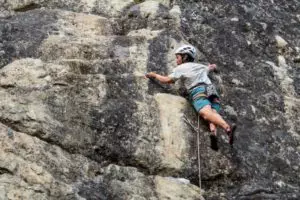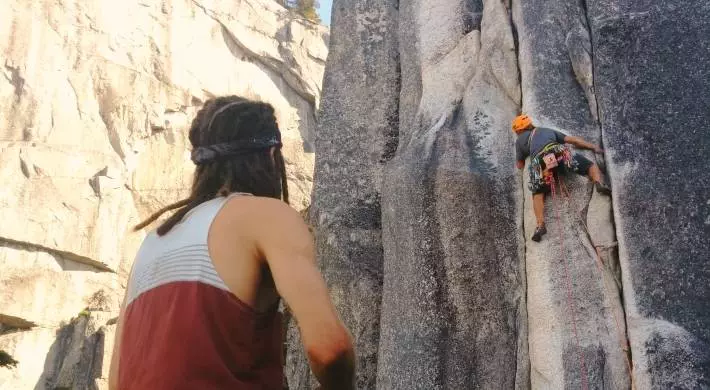Climbing can be incredibly fulfilling. Ascending a near-vertical face of rock with a bag of chalk and a pair of sticky-rubber shoes lends a feeling of accomplishment felt in few other outdoor pursuits. Previously we’ve shared MSAA’s Beginner’s Guide to Rock Climbing about the perceived barriers of entry to the sport and how to overcome them. If you are now climbing comfortably on some more difficult routes, have had some experience setting up a safe top rope system and are looking for a new challenge, it’s time to take a step into the world of lead climbing. If your looking to learn more about all of our climbing courses, then please click here to learn more.

Why Lead Climbing?
Top roping (when the climber is belayed from a rope above) is great for a few reasons. It allows tentative beginner and novice climbers to feel secure when they try new moves or routes. It allows advanced climbers to push themselves physically with low fall consequence. When a climber falls on a top rope, they ideally only fall as far as the rope stretches.
But there’s a few drawbacks to top roping. The belay rope gets in the way of hand holds. Venturing more than a foot or two laterally away from the rope’s line means it will begins to tug at the climber’s harness and affecting their balance. It also requires hiking or scrambling access to the anchor point in order to set up the belay system.

Lead climbing belays the climber from below with the leader setting protection points (either on permanent bolts or using removable crack-jamming devices) as they ascend. This gives the climber greater freedom of movement, but also means a fall will result in the climber plunging twice the distance from their last protection point. In short, falling while lead climbing is dangerous and should be weighed up with your climbing ability, risk tolerance and choice of route.

Getting Prepared for Lead Climbing
Prior to tackling your first lead, it’s worth taking a course and getting educated on elements such as belaying technique, protection placement and using natural and man-made features to build anchors. After some initial training, find a partner with plenty of lead climbing experience so you can watch their process. A great way to get introduced to lead climbing is to “second” the leader. This is when you first belay the leader then climb the same route (belayed from the top) and clean the route of protection. Not only do you need to focus on the actual climbing, but you’ll need to free a hand to remove all those cams, nuts and quickdraws.
Another great way to practice leading is to set up a normal top rope belay then add a lead rope to your harness from below. You can then try placing protection and threading the lead rope all while secured to your familiar belay system.

Taking the Lead
The first stop for aspiring lead climbers is sport climbing. This is lead climbing on bolted routes where you place protection by clipping a quickdraw to the bolt hanger then clipping the rope through the opposite end of the quickdraw. This gives the climber more time and energy to concentrate on the climbing itself rather than sifting through a full rack of gear.
An important consideration when starting to lead climb is knowing your limits. Leading requires significantly more stamina since you have to hang off one arm to place protection and thread the rope every few metres. Always bump down your climbing grade a couple of points while you learn how to efficiently place protection and conserve your energy.

Traditional or “trad” climbing is leading up non-bolted routes that require climbers to completely place all their own protection. It’s considered the purest form of roped rock climbing and requires investment into a well-stocked rack of gear. Climbers attempting trad for their first time should consider the extra weight to carry and the extra effort required to place and test protection.
Another consideration of lead climbing is trust. You need to have confidence in your own abilities and gear but also that of your climbing partner. That trust is built up incrementally over time and should not be rushed. Good trust between climber and belayer starts with clear communication.
Some folks will happily stay on top ropes for their climbing careers, but if you want to one day ascend multi-pitch routes on mountains and experience the true essence of the sport, the only choice is to lead.
Photos by Dan O’Keefe
updated Jun 12th 2018

